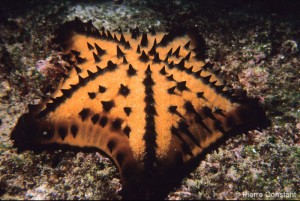 If you’re like us here at WoWasis, you’ll go scuba diving or snorkeling in the Galapágos Islands, then come back to your hotel wondering what you saw. Then you’ll go looking in several of the tourist shops looking for a good marine life guidebook. But you won’t find one. Instead, you’ll find plastic fish charts with limited numbers of examples and an expensive guide to Galapagos fish that will ignore invertebrates. That’s too bad, because colorful invertebrates constitute a lot of what you see below the surface (if you’re looking for Galapagos land life books, see our book review of Wild Life of the Galápagos).
If you’re like us here at WoWasis, you’ll go scuba diving or snorkeling in the Galapágos Islands, then come back to your hotel wondering what you saw. Then you’ll go looking in several of the tourist shops looking for a good marine life guidebook. But you won’t find one. Instead, you’ll find plastic fish charts with limited numbers of examples and an expensive guide to Galapagos fish that will ignore invertebrates. That’s too bad, because colorful invertebrates constitute a lot of what you see below the surface (if you’re looking for Galapagos land life books, see our book review of Wild Life of the Galápagos).
Pierre Constant’s Marine Life of the Galapagos: The Diver’s Guide to Fishes, Whales, Dolphins, and Marine Invertebrates (2007, ISBN 10: 962-217-767-0) is just what you’d need. And we’d recommend that you buy it before your trip and take it with you, as it’s not all that easy to find when you arrive. In this book, there are 288 color photographs, 27 maps and illustrations, and 30 pages of biological and geological data that explain why the currents move they do, how water temperature contributes to the marine life, you name it.

Nidorellia armata, photo courtesy Pierre Constant
Each photograph is keyed to a short paragraph describing the marine animal, and the index is keyed to English, French, and Spanish common names. Then there’s a scientific name index as well. The guide is small enough to fit into your bag, so you could easily take it aboard your boat, although it’s so pretty that you won’t want to get sea water on it.
What got us moving away from books that solely focus on fish was the fact that one of the most beautiful things we saw underwater was a starfish, iridescent yellow with black spines. It wasn’t in the fish book because it’s not a fish. We found it in Constant’s book, and it’s called a Chocolate chip star, or Nidorellia armata. But we wish we’d known what it was then, or at least been able to take the guidebook back to the hotel and look at the pictures over a beer. Constant also provides great vignettes about marine life that’s deadly or poisonous. Even though you’re not to touch anything down there anyway, aren’t you now glad that you didn’t?
 Constant’s a veteran diver and underwater photographer, runs a dive operation on Isabela, and he’s a good writer. He puts the book is easy-to-understand classifications too, so you don’t have to be a marine biologist to understand everything. It will be too late when you get to Puerto Ayora on Isla Santa Cruz, as they don’t sell it there (or maybe they do, but it sells out quickly). Our recommendation? Buy it now at the WoWasis eStore before you go.
Constant’s a veteran diver and underwater photographer, runs a dive operation on Isabela, and he’s a good writer. He puts the book is easy-to-understand classifications too, so you don’t have to be a marine biologist to understand everything. It will be too late when you get to Puerto Ayora on Isla Santa Cruz, as they don’t sell it there (or maybe they do, but it sells out quickly). Our recommendation? Buy it now at the WoWasis eStore before you go.
Leave a Reply